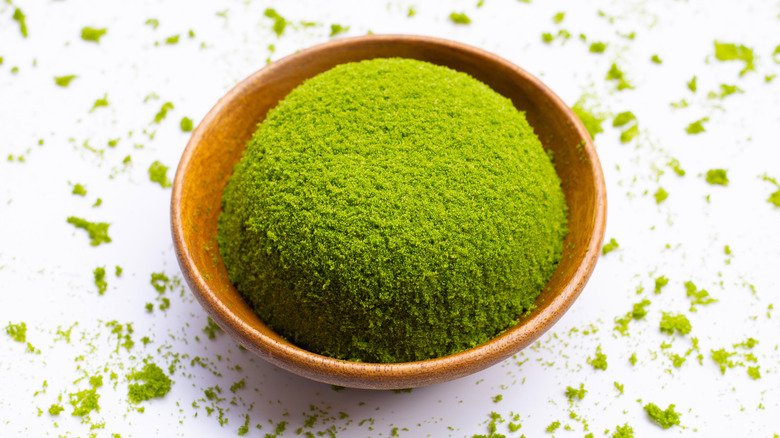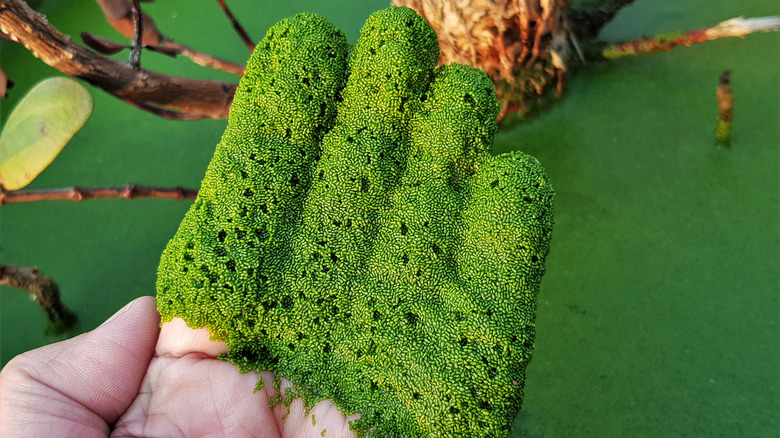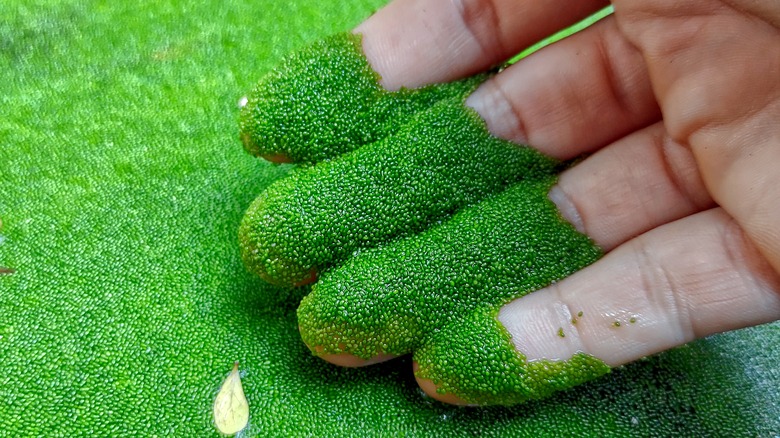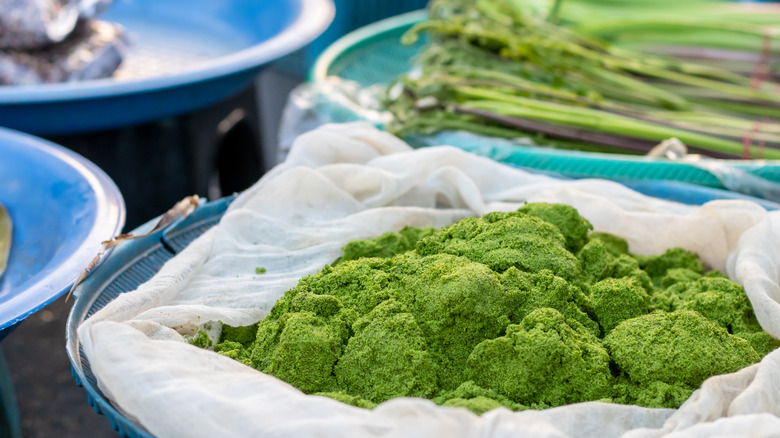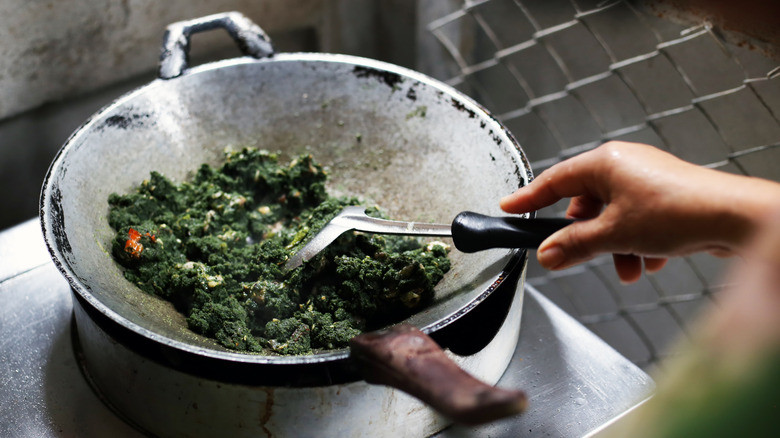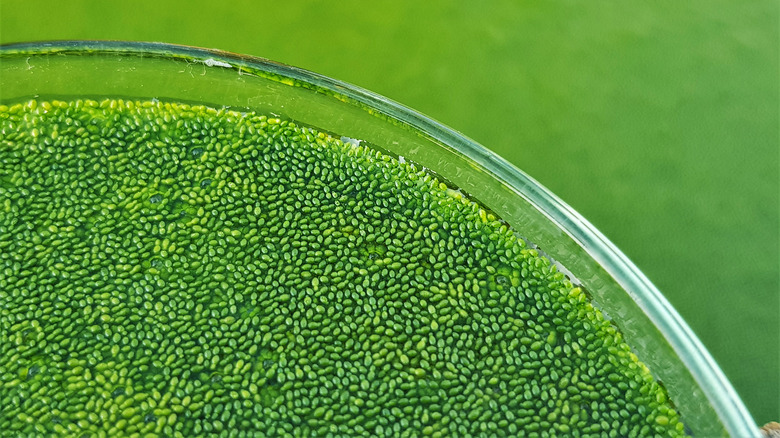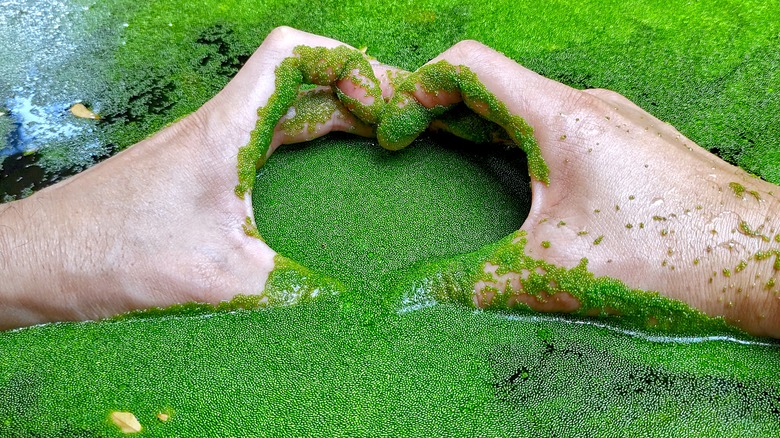The World's Smallest Fruit Is Stunningly Nutritious
A type of pond-floating duckweed, the Asian watermeal plant (Wolffia globosa) may bear the world's smallest flower and fruit, but it offers up a massive-sized nutritional profile that rivals or surpasses some of the world's best-known superfoods. Used as a food source for thousands of years in Thailand, Wolffia globosa contains more protein per weight than soybeans and is the only known plant-based source of non-animal-derived vitamin B12.
Found in still waters worldwide, Wolffia is not yet commercially available outside of Asia, however, its possibilities are far-reaching. Cultivating watermeal in aqua farms is sustainable and eco-friendly, using far less land and water to grow than traditional farming and animal husbandry. As a complete protein, it is a perfect ingredient for the development of plant-based meat alternatives and a healthy source of nutrients for vegetarian and vegan diets. It could also play a key role in addressing food scarcity and malnutrition.
While we wait for greater availability of this miniature protein powerhouse, we can discover what makes little Wolffia globosa so unique, aside from its flower being so small that your unaided eye would not even be able to see it. Not to be confused with pond scum, which is an algae, the watermeal plant has both an interesting history and a promising future. From inventive new ways of growing it to innovative ways chefs are adding it to their menus, this fascinating and novel food seems worth waiting for. Read on to find out why.
What is Wolffia globosa watermeal?
Watermeal is a type of duckweed, a green aquatic plant that grows on the surface water of ponds, lakes, swamps, and marshes. Also known as Asian watermeal, it is more commonly referred to by its scientific name, or the shortened version, Wolffia. It is the smallest of all duckweed, smaller even than a grain of table salt. It has the dual distinction of being the smallest flowering plant in the world, with a flower that produces the world's smallest fruit. Measuring no more than 1/64 of an inch, the Library of Congress estimates it would take at least 5000 of the minuscule plants to fill a thimble. Its microscopic fruit is so tiny that it cannot be seen by the naked eye.
Duckweeds are a species in the subfamily Lemnoideae of the Araceae family, also known as Arums, which include Jack-in-the-pulpit, calla lilies, and philodendron. Wolffia plants reproduce asexually and have no roots, branches, or leaves. Like all duckweeds, Wolffia globosa grows at an exceptionally fast pace. This makes it a popular surface cover in garden ponds and aquarium tanks.
Native to tropical and subtropical Asia, duckweeds are found worldwide. For centuries, they have been harvested from waterways and used in the cuisines of Thailand, Myanmar, Laos, and Cambodia. In Thai food, duckweed is called khai-nam, which means "water eggs," and is sometimes referred to as Mankai, the trademarked name for a cultivated strain of Wolffia globosa.
How is watermeal duckweed grown?
Wolffia watermeal grows abundantly in ponds, lakes, and other still waterways. The rapid rate at which they can reproduce, doubling their numbers in two days, is why they can often be seen completely covering large areas of water. Wolffia from these waters has traditionally been harvested for food in places like northern Thailand. The plants also serve as food for birds and other wildlife, and their blanketing of water surfaces helps control mosquito populations and algae blooms. While welcomed in decorative ponds, watermeal can also sometimes be a nuisance in the wild. In some areas, duckweeds are considered invasive, as their mass numbers can block sunlight from reaching underwater plant life, starving the water of oxygen, and leading to fish die-offs.
While commercial Wolffia globosa has yet to become available on a large scale, companies are cultivating it on aqua farms and experimenting with cutting-edge production methods for bringing this up-and-coming protein food source to buyers worldwide.
Even more promising is that watermeal can be grown sustainably, with far less water use required than traditional farming practices. There are no concerns over animal welfare, fertilizer run-off, or chemical pollution. Growing wolffia using advanced aquaculture and hydroponic techniques can be done year-round in controlled environments, requiring far less land usage than traditional crops or animal factory farms.
What does Wolffia globosa taste like?
Wolffia watermeal has little flavor of its own and is consumed more for its nutritional benefits than for its taste. This neutrality makes it extremely easy to incorporate into various foods and drinks, either raw, frozen, or dried, powdered. It can be added to almost anything without affecting the taste much at all, aside from adding volume and texture, which is akin to soft breadcrumbs or cornmeal. It also adds a vibrant, bright-green color to anything it is added to, making it an all-natural food coloring and dye.
The Thailand-based company, flo Wolffia, cultivates a line of Wolffia globosa products and describes Wolffia as having a very mild spinach flavor with no bitter aftertaste and a scent reminiscent of matcha green tea. It is suggested as a terrific addition to pasta doughs and sauces, in very green pesto, and as a pizza topping. Likewise, the producers of Mankai wolffia describe watermeal as tasting faintly of lettuce, while according to Mental Floss, it has more of a watercress flavor.
How to cook with Wolffia globosa
Wolffia and other duckweeds are eaten primarily in Southeast Asian cuisines, especially in Thailand, where it is known as khai-nam, and sometimes pum or phan. It can be eaten raw or cooked and is usually used in curries, egg omelets, noodle soups, baked goods, fruit smoothies, and green juices. Despite watermeal's lack of flavor, the nutritional boost that it easily adds to any dish makes it a desirable ingredient. From savory dishes to sweets, adding a boost of protein, vitamins, and fiber to any dish or beverage is as effortless as topping it with a scoop of Wolffia. Given its long history, creative and refined recipes have evolved that feature it.
This recipe for Nam Prik Ong Hed by The Holistic Chef combines traditional Thai chili paste with Wolffia, tofu, and mushrooms and is served with dark-green buckwheat wraps made with watermeal batter. They also created what has been dubbed "the world's first vegan cheesecake featuring Wolffia globosa." The unique mix of eye-popping green watermeal with cashew nuts, longan berry, coconut, papaya, and passion fruit creates a stunningly beautiful dessert.
We found examples of how to cook with watermeal on YouTube as well. In this video, Wolffia globosa curry with tofu and coconut by Spanish martial artist-turned-Thai-foodie Pedro Solana, is served with a duckweed-infused omelet. Another video by flo shows how wolffia can be used to bake whole-grain bread. Watermeal itself is gluten-free and provides moisture and thickness to all types of baking.
Nutritional information about Wolffia globosa
Considering watermeal's minuscule size, its nutrient content is impressive. A true superfood — Wolffia globosa is one of the only plants that is completely protein, with all essential amino acids and up to 40% protein per dry weight. In comparison, soy contains 36% protein; lentils have 24%, and quinoa 14%. This positions Wolffia as a valuable and sustainable meat alternative.
Wolffia globosa is high in omega-3 fatty acids, minerals, antioxidants and is gluten-free. One cup contains the same amount of fiber as seven stalks of celery, the iron equivalent of 10 cups of broccoli, calcium equal to four and a half cups of spinach, and two cups of peas worth of zinc (via flo). In a study published in Nutrients Journal by MPDI, researchers discovered that Wolffia globosa is high in B12, making it the only known plant-based source of the vitamin. This is important because B12 is the only nutrient that cannot be derived from food in vegan diets.
Not all duckweeds are edible, so proper identification is necessary. Unless watermeal is cultivated under controlled conditions, contaminants and bacteria from its water source may be present. It is not advised to harvest wild watermeal unless from a trusted source, but if foraged, it should always be washed and boiled before eating. If clean specimens are available, Wolffia can be propagated and grown at home in dedicated tanks or pools.
Where to buy Wolffia globosa
As of July 2023, there are no large-scale, commercially available sources for purchasing Wolffia globosa in the United States. Flo Wolffia has developed watermeal aquaculture facilities in Thailand, where its Wolffia products are available in grocery stores. We reached out to the company to inquire about purchasing options, but it currently does not sell or ship to the United States.
Another company that contributed to the growing interest in Wolffia globosa, and popularized it by its alternate name, Mankai, ceased operating in June of 2022. A biology company based in San Diego, California, named Plantible has developed a protein product made from the lemna plant, more commonly known as a water lentil. Lemna is a duckweed similar in appearance and nutritional value to Wolffia, although it is not as tiny. Plantible only partners with plant-based packaged food companies and does not sell directly to the public. Similarly, the company Lemnature USA, formerly known as Parabel, has large aqua farms in Vero Beach, Florida, where it cultivates and develops lemna protein for the food industry. But it, too, does not supply directly to the public.
The potential for duckweed-based foods, especially from the tiny nutritional powerhouse Wolffia globosa, seems like a huge opportunity waiting to be explored both for the United States and the global market.

